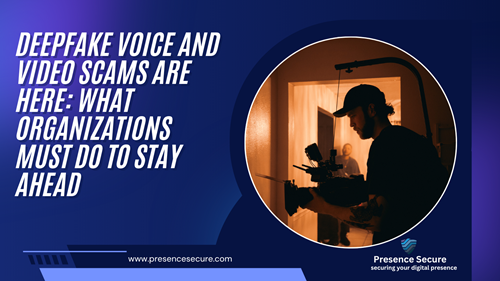In the age of AI-powered deception, hearing your CEO’s voice or seeing a familiar face on video no longer guarantees authenticity.
Deepfake scams once a sci-fi concept are now a real and rising threat to businesses, governments, and institutions worldwide. By mimicking the voice, facial expressions, and mannerisms of trusted individuals, cybercriminals can launch devastating attacks that bypass traditional verification processes and exploit our deepest instincts: trust and urgency.
The question is no longer if your organization will be targeted it’s when. And more importantly: Will you be ready?
What Are Deepfake Voice and Video Scams?
Deepfakes are synthetic media generated by AI. They can produce realistic audio clips, video footage, or even live streams that convincingly impersonate real people.
Attackers use these tools to impersonate:
- CEOs requesting urgent transfers.
- Suppliers requesting updated account details.
- HR managers discussing payroll changes.
- Lawyers authorizing sensitive documents.
These scams are no longer limited to high-profile corporations. Small and medium-sized businesses, NGOs, and local governments are all vulnerable.
Why Are These Scams Spreading So Fast?
- Low Cost, High Impact
Deepfake tools are free or cheap online. Even amateur attackers can generate convincing fakes with just minutes of voice/video samples. - More Data, More Training Material
Company leaders are often visible online through interviews, webinars, and social media giving attackers the data needed to train AI models. - Speed and Sophistication
Deepfakes can now be created in real time, making them useful in live video calls and voice-based support systems.
Examples
- Voice Clone Scam (2023): A Hong Kong firm lost $25 million after staff were tricked into wiring money following a video conference with AI-generated avatars mimicking senior executives.
- AI Phone Call Attack (2020): A UK energy firm was defrauded of €220,000 after a senior employee received a deepfake voice call from someone who sounded exactly like the CEO.
These are not isolated incidents they are a warning sign.
How Organizations Can Stay Ahead
To protect against this new era of social engineering, organizations must adopt a multi-layered defense strategy.
- Strengthen Human Verification Processes
- Implement two-person verification for financial or sensitive decisions.
- Require call-back procedures for verbal requests, especially if the voice sounds familiar but the request feels unusual.
- Educate Teams About Deepfakes
- Train all employees, especially those in IT, finance and HR, to question urgent or emotional requests — even if they seem to come from “trusted” voices or faces.
- Incorporate deepfake awareness into phishing simulations and security training.
- Use Secure Communication Channels
- Avoid making critical decisions based on messages received via unsecured platforms (e.g., personal email, WhatsApp).
- Use encrypted video conferencing tools with authentication features.
- Deploy Deepfake Detection Tools
- Integrate AI-based detection software into communications workflows.
- Monitor voice and video for signs of manipulation, such as blinking irregularities or audio artifacts.
- Limit Executive Media Exposure
- Encourage leaders to restrict the volume of public video/audio content shared online.
- Consider watermarking public videos or using digital signatures on communications.
A New Era of Cybersecurity Awareness
In the past, security depended on passwords and firewalls. Today, it requires a mindset shift: the understanding that not everything you see or hear is real.
Executives, employees, and customers must all be trained to verify first trust later.
Deepfake scams represent a fusion of technology and psychology, and defending against them demands both technical solutions and human vigilance.
Summary
Deepfake threats are not just coming they’re already here.
Organizations that act now with education, policy changes, and tech tools will be better positioned to spot the fakes, stop the fraud, and build real trust in a world of artificial deception.

